It goes without saying that Serbia is one of the most underrated countries in Europe. Even within the European community, Serbia is seen as slightly exotic, with most trips to the Balkans going in favor of neighboring Croatia, Montenegro and even Bosnia & Herzegovina. Serbia probably remains as one of Europe’s best kept secrets with plenty to keep the traveler busy, whether it be for a quick city break or a longer trip covering the great outdoors. This itinerary is meant to cover the main things to do in Serbia within a relatively short span of time, and portions of this can be done in as little as 2 days if a weekend city break to Belgrade is all you are after, to as much as 5 days if you have more time to spare to visit the cities of Vojvodina as well.
Table of Contents
Day 1 – Belgrade (City Center)
Tip: taxis in Belgrade are notorious for scamming passengers, especially foreigners. I went with a taxi after arriving in Belgrade station thinking it was safe because it had a meter. Turned out to be a fake meter. It jumped so fast I ended up paying 20 Euros for a 10 minute ride (should have been more like 5 euros or less). To distinguish a real taxi, make sure it has the city’s coat of arms on the roof with a number. Reliable taxi companies include: Pink Taxi and Beogradski Taxi and you can request any establishment you’re in (i.e. hotel, restaurant, shop) to call one for you.
Arrive in Belgrade, literally the “white city” and the capital of Serbia. If you are arriving through Nikola Tesla International Airport, you need to be wary of unscrupulous taxi drivers who may overcharge you for a ride to the city. The usual taxi fare to the city center of Belgrade from the airport is 1800 to 2000 Dinars and you can get a cab from the taxi desk.

kalemegdan fortress belgrade
Start your day with a stroll to Knez Mihaila which is Belgrade’s high street. Here, you’ll find plenty of chic shops interspersed with cafes and fine restaurants. In case it is still too early to do some decent shopping – no problem. There are a number of points here to interest tourists including the old National Bank of Serbia building with its fine neoclassical interiors, Hotel Moskva which is just one or two blocks south from the beginning of Knez Mihaila as well as Trg Republik (Republic Square). At the northern end of the street, you will find pathways leading up to a hill with a fortress. This is the Kalemegdan Fortress which is one of the most recognized landmarks in all of Belgrade. Look out for the instagrammable spots here including the arches that look out to fine views of the river as well as the highest point which allow for views of the point where the Danube and Sava rivers meet.

prolece restaurant in belgrade
After working up an appetite, you can head back to the Knez Mihaila area for lunch. A popular spot for local food is Prolece which serves up a number of hearty dishes including meat stews that are just perfect during cold days. If you are feeling luxurious, you can check out Salon 1905 which is probably the city’s most over-the-top restaurant with its plush palatial interiors.
Tip: To navigate Belgrade’s public transport system, I recommend using Moovit. This app is useful if you plan to travel around the Balkans. They also cover other cities in Serbia such as Novi Sad as well as Sarajevo in Bosnia-Herzegovina.
skandalija in belgrade
You can spend the afternoon exploring the rest of Belgrade’s inner city areas. Skandarlija is probably the closest that the city has to an old town. It’s one relatively long street paved in cobblestone. There are restaurants lining the streets. Some are proud to display the famous people who have eaten in their establishments.
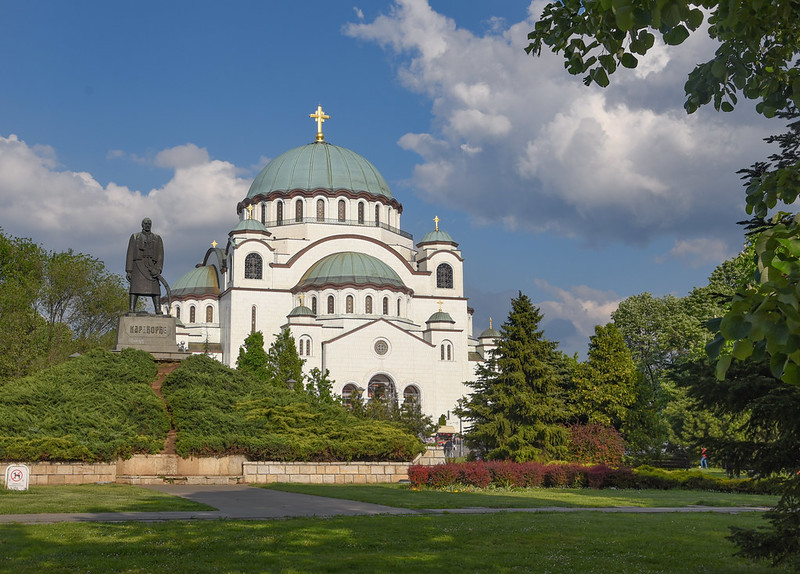
st. sava temple
During the late afternoon, take a long stroll down Kralja Milana and admire the beautiful buildings along the way as you walk towards the imposing St. Sava Temple. Admission to the largest church in Serbia is free. The highlight is the crypt in the basement which is adorned with religious artwork in the columns as well as ceiling. Opening times to the actual crypt vary. I was in Belgrade for four days and attempted to enter the crypt each day I was there. However, I was only successful during the first day. Nevertheless, even if you don’t manage to see the crypt, the exterior of St. Save Temple is also a sight to behold especially at night when it is floodlit. Hardworking photographers sometimes book a cheap room in the nearby Hotel Slavija where they can capture a higher view of the St. Sava Temple.
Day 2 – Belgrade (Suburbs)

belgrade skyline
The second day in Belgrade can be utilized to explore the suburban parts of the city. A popular excursion is to Zemun. The Sava River once served as the border between Serbia and Austria-Hungary so anything east of the river was part of Austria-Hungary. This is why the suburb of Zemun has a distinctive small town Austrian feel with its church towers and charming buildings. You can climb up to Gardos Tower for a bird’s eye view of Zemun. On the way to Zemun from downtown Belgrade, you can also pass by the boxy Museum of Contemporary Art (open 10AM to 6PM daily except Tuesdays). Even if you don’t have a passing interest for art, the exterior of the museum is worth checking out for its striking architecture.
If you have time, you can also head south and check out The Royal Palace and White Palace in the suburb of Dedinje. The Royal Palace in particular is adorned with intricate frescoes. Admission fee is RSD 650 and tours need to be booked in advance. You can find more details here.

tasmajdan park
You can then choose to depart for Subotica in the evening or wait til the next morning for the 2.5 hour trip. If you decide to stay in Belgrade, Restoran Tri (Kosovska 51, open daily except Sunday from 12PM to 12AM) is a nice hipster-ish dining option for food and cocktails. Belgrade’s scenic Tasmajdan Park is also just next door which makes an after dinner stroll a good option. If you happen to be in Belgrade around October, Tasmajdan Park is also said to be one of the best places in Belgrade to see autumn colors.
Day 3 – Subotica
Subotica used to be one the largest cities in Serbia but waves of emigration to Hungary which is just across the border has kept the local population on a slight gradual decline. The city is known for its multiculturalism and a good proportion of the city folk are actually bilingual in Serbian and Hungarian.
I specifically made the effort to visit Subotica after seeing photos of its beautiful art nouveau architecture. And indeed, despite having visited several old towns in Europe, the cityscape of Subotica did not disappoint.
Subotica is a relatively small town with a compact and walkable center. The entire city can be explored in as short as 2 hours but I opted to stay overnight in order to capture photos of the old town in the evening.

city hall of subotica
While here, make sure to check out the City Hall which serves as the focal point of the city. The beautiful red building was built in the early 20th century and even features elements of Hungarian folklore. Entry is possible at 12 noon from Tuesdays to Fridays. The highlight of the admission, other than the sumptuous interiors, is access to the observatory with views of the city. There are two fountains surrounding the city hall, one blue and another green. While often touted as a tourist attraction in the local guides, I found it a bit of a distraction especially in my attempts of taking good photos of the city hall.

korzo street in subotica
Afterwards, head east towards the direction of the Neo-classical Public Library. You will see a pedestrian-only shopping street called Korzo which serves as the “high street” Subotica. You won’t really find any big-name brands here but the area is worth a stroll in order to see more art nouveau structures including the former Golden Lamb Hotel and former Subotica Savings Bank.
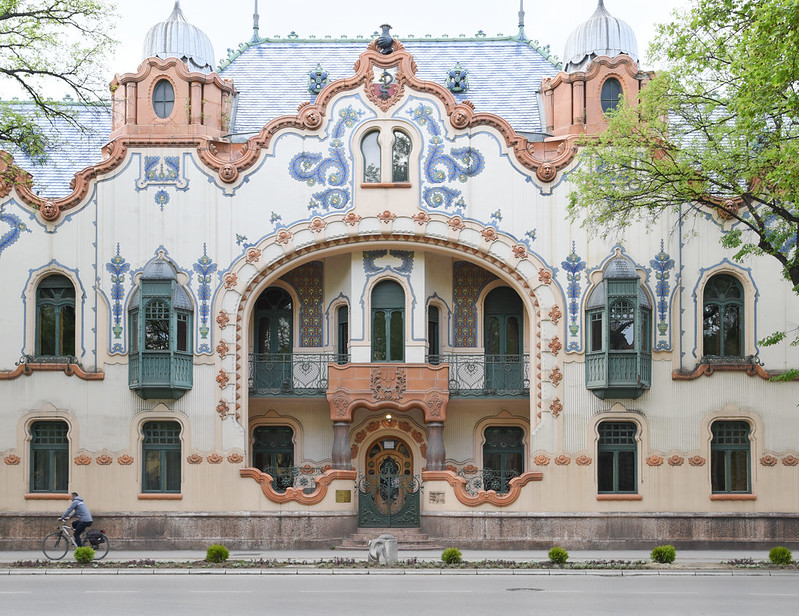
beautiful raichle palace in subotica
Turn left at the end of Korzo Street and walk a few meters to reach the unusual Raichle Palace. Pictures can speak a thousand words and honestly, it was a photo of this building that made me want to go to Subotica (and Serbia generally). The house was built in 1904 by noted architect Ferenc Raichle as a personal home. Today, it serves as an art gallery.

synagogue of subotica
While in Subotica, also make sure to visit the Synagogue which is one of the largest in Europe. The interiors have been renovated and now feature a palatian concert hall look. Visits are available by appointment.
Before leaving Subotica, make sure to visit the nearby lake called Palic. To get here from Subotica, take #6 bus which runs every 20 minutes. Palic is a popular day trip option for locals looking to relax and cool off during the summer months but regardless of the season, you can appreciate the fine art nouveau architecture here including the Water Tower and Women’s Lido.
Where to eat in Subotica: Even locals recommend having dinner at Boss Cafe (Matije Korvina 7-8, open daily until late). There is a wide array of dishes here including Asian! I tried the pizza and pasta and these were delicious.
Day 4 – Novi Sad
From Subotica, Novi Sad is about an hour’s bus ride away. There are several departures daily which you can check here. Novi Sad is the second largest city in Serbia but its places of interest are near each other that you can comfortably get an overview of the city within a day. From the Novi Sad main bus terminal, you can take a number of local city buses to the old town.

old town hall of subotica
Novi Sad has one of the most charming old town squares (Trg Slobode) in Europe. With a strong Austrian influence, it is definitely unlike any other in Serbia. It is also especially atmospheric in the day while local violinists play music such as the Blue Danube Waltz (an especially apt number given the Danube snakes its way across town). The main buildings to see here are the Old Town Hall and the imposing Name of Mary Church.
If you happen to be near the old town square during lunch time, I highly recommend checking out Fish & Zelenis (Skerlićeva 2, Novi Sad 21000). For a landlocked country, the quality of seafood here really surprised me. Do check out the daily special. They were offering Turbot when I was there and it was cooked to tender perfection! The staff members here are also very friendly and highly knowledgeable about the food and drinks.
From the main square, make your way towards Dunavska – the city’s high street – with its array of charming shophouses. The street conveniently ends right by the Danube, affording one of sweeping views of Petrovardin Fortress.
Where to Stay in Belgrade, Novi Sad and Subotica
Belgrade – I can’t recommend the Hilton Belgrade enough. Located in Kralja Milana, you can walk to either Trg Republik or St. Sava Temple with its central location. Rooms are very new. This is probably the most luxurious hotel today in Belgrade but prices are reasonable at just above US$100 per night on average.
Subotica – Hotel Galleria is the most popular hotel in Subotica. From its rooftop restaurant, you can even get a partial view of the Old Town Hall.
Novi Sad – Since Belgrade is just an hour away by bus, I would recommend spending the night in Belgrade instead.
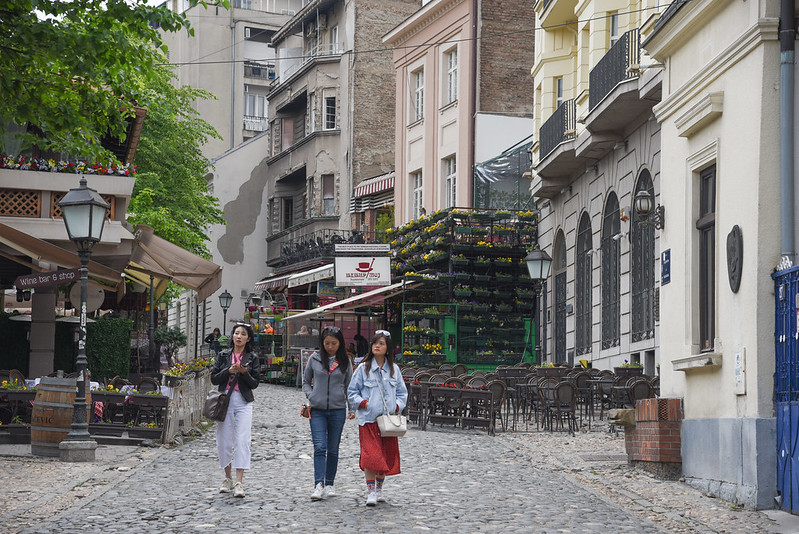

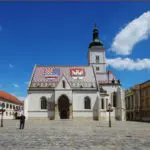
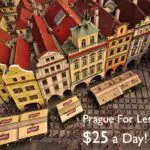



Leave a Reply